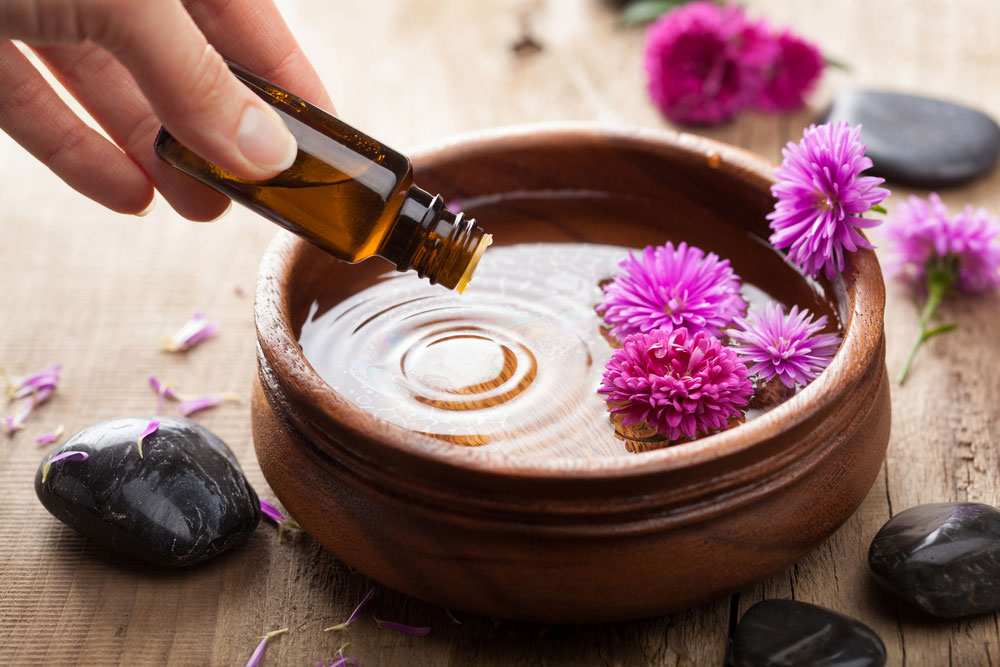What Are Essential Oils?
Essential oils are concentrated hydrophobic liquids with volatile aroma compounds derived from plants. These oils are natural aromatic compounds taken from different parts of plants namely the bark, seeds, stems, flowers, and roots.
These oils are also known as ethereal oils, volatile oils, and aetherolea.
The extracted oil is important because it carries both a unique scent as well as the essence of the plant.
Essential oils can be both powerfully and beautifully fragrant, and in addition to their distinctive scent, these oils provide plants their needed protection against diseases and plant-eating animals. They also play a role in plants’ pollination.

By Olga Miltsova / shutterstock.com
Volatile aromatic compounds that are non-water based phytochemicals make up essential oils.
These oils may be soluble to fat but they don’t include acids or fatty lipids found in animal or vegetable oils.
They are clean, almost crisp, and are absorbent. Unadulterated and pure essential oils are translucent, and their colors vary from crystal clear to deep blue.
Essential Oils through Time
Essential oils are also a part of history. It was said that the Egyptians first used aromatic essential oils for beauty treatments, medical practice, food preparation, and religious ceremonies. They also traded oils such as sandalwood and frankincense in exchange for gold; the oils were considered as valuable cargo during those times.
Aside from the Egyptians, the Greeks also used essential oils. They used those oils for the practice of aromatherapy and therapeutic massage.
The Romans used aromatic oils as well for personal hygiene and health purposes.
Persians, on the other hand, started to use distillation methods to extract oils from aromatic plants.
In Europe, oil extracts were utilized throughout the dark ages for fragrant and antibacterial properties.
Modern times have rediscovered the healing properties of essential oils through a
French chemist named Rene-Maurice Gattefosse. What he did was to treat a badly burned hand using pure lavender oil.
During World War II, essential oils were also used to treat injured soldiers. The
Bible even has 188 references to essential oils.
The use of essential oils continued to grow quickly as medical practitioners and health scientists research and validate the benefits that can be obtained from using therapeutic essential oils.
Characteristics of Essential Oils
Essential oils can be described in a lot of ways. Here are some characteristics and some points to ponder about essential oils:
- Essential oils are organic substances that help the body approach equilibrium without having to cause harmful side effects.
The essential oils to be used must be therapeutic grade, though, instead of the perfume grade ones, so that they won’t contain harmful chemicals. - Essential oils can easily penetrate the cellular and skin membranes.
They are miniscule in size, and so they are absorbed well by the skin that’s why they are perfect ingredients for certain personal care items.
They don’t accumulate in the body, though; they just provide their healing properties, and then pass on through.
- Essential oils are commonly used in cosmetics, soaps, perfumes, essences or massage oils. The oils have to be combined with a base or carrier oil such as sesame, almond, coconut, or olive oil to reduce its strength. Essential oils are so concentrated that they have to be diluted, or else they may cause an unfortunate allergic reaction to your skin.
- Essential oils can last for at least five years. A bottle of essential oil could last a decade.
The oils are so concentrated; you’ll only need a small amount for every application which makes them last a long time.
However, citrus oils are not included here since their potency diminishes after a year or two. - Essential oils should be stored in dark glass bottles, and they should be placed out of direct sunlight. By doing so, you will help preserve the oils’ potency. Keep the oils out of children’s reach, and keep away from contact with your eyes.
- If you’re sensitive or allergic to the food or to the plant, then you’ll also be sensitive or allergic to the oil. Hence, if you can’t eat sage without getting rashes and itchiness all over, then you might as well avoid the oil since it will cause the same effects.
- An essential oil that is more expensive is not necessarily a better treatment. Even if it’s just a small price variation, it will not indicate better quality.
A little tip: if you’re using the essential oils for non-therapeutic purposes, then it’s okay to use the less expensive ones.
If you need the oils for therapeutic purposes, then it’s okay to spend a little more for higher quality. - Want to see how pure your essential oil is? Place a single drop on a sheet of construction paper. If the oil evaporates quickly without leaving any noticeable rings, then it’s pure. If it leaves a ring, then the manufacturer likely diluted it with a different oil of some sort (Keep in mind, though, that this test won’t work for oils such as patchouli, myrrh, and absolutes.).
Essential oils have always been held in high regard even by doctors and medical professionals to use in skin application, aromatherapy, and consumption.
Research is still being conducted to reveal the other benefits and healing properties that essential oils offer.
